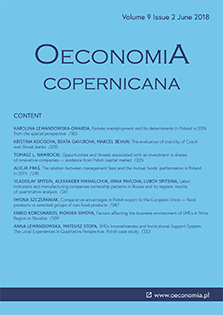Labor indicators and manufacturing companies ownership patterns in Russia and its regions: Results of quantitative analysis
Labor indicators and manufacturing companies ownership patterns in Russia and its regions: Results of quantitative analysis
Author(s): Vladislav Spitsin, Alexander Alexandrovich Mikhalchuk, Irina Pavlova, Lubov SpitsinaSubject(s): Business Economy / Management, Labor relations, Economic development, Transformation Period (1990 - 2010), Present Times (2010 - today)
Published by: Instytut Badań Gospodarczych
Keywords: foreign direct investments (FDI); manufacturing industry, employment effects; economic productivity; economic crisis;
Summary/Abstract: Research background: There has been an extensive process of foreign and joint ownership enterprises establishment in the Russian economy since 2006. Domestic manufacturing industry has been experiencing certain pressure on behalf of foreign direct investment bringing new technologies and higher labor requirements. Purpose of the article: The aim of this paper is to investigate differences in employment strategies and labor indicators in the case of enterprises in foreign and joint ownership (FJO) and domestic enterprises in Russian ownership (RO). We analyze the manufacturing industry in Russia and its regions under conditions of stable and crisis periods. Methods: The study enhances the analysis of Rosstat’s statistical data for 2005–2016 and applies ANOVA method to compare the employment results for companies with different ownership patterns. The research is carried out both at the national level of the Russian Federation and at the regional level according to the regions. Findings & Value added: The study identifies significant decline in employment and increase in productivity for the period of 2005–2016. In contrast to the crisis of 2008–2009, in 2014–2016 there has been no sharp drop in employment. However, there is a substantial decline in real salaries which is comparable to the crisis of 2008-2009. According to ANOVA, statistically significant differences in labor indicators between FJO and RO companies are manifested. RO companies dominate in employment and payroll funds, while FJO enterprises have better productivity results with a higher average salary. FJO companies demonstrated faster growth in employment and payroll fund in relatively stable conditions (2012– 2013). However, they reacted with a significant reduction in employment for a new crisis (2014–2016), although the creation of new FJO enterprises continued in separate regions of Russia. The results can be used in social policy to regulate the employment and earnings of industrial workers in the current economic conditions.
Journal: Oeconomia Copernicana
- Issue Year: 9/2018
- Issue No: 2
- Page Range: 261-285
- Page Count: 25
- Language: English

